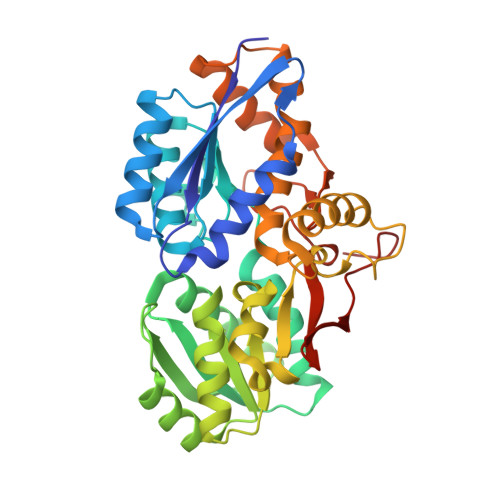The CouPSTU and TarPQM Transporters in Rhodopseudomonas palustris: Redundant, Promiscuous Uptake Systems for Lignin-Derived Aromatic Substrates.
Salmon, R.C., Cliff, M.J., Rafferty, J.B., Kelly, D.J.(2013) PLoS One 8: e59844-e59844
- PubMed: 23555803
- DOI: https://doi.org/10.1371/journal.pone.0059844
- Primary Citation of Related Structures:
4JB0, 4JB2 - PubMed Abstract:
The biodegradation of lignin, one of the most abundant carbon compounds on Earth, has important biotechnological applications in the derivation of useful products from lignocellulosic wastes. The purple photosynthetic bacterium Rhodopseudomonas palustris is able to grow photoheterotrophically under anaerobic conditions on a range of phenylpropeneoid lignin monomers, including coumarate, ferulate, caffeate, and cinnamate. RPA1789 (CouP) is the periplasmic binding-protein component of an ABC system (CouPSTU; RPA1789, RPA1791-1793), which has previously been implicated in the active transport of this class of aromatic substrate. Here, we show using both intrinsic tryptophan fluorescence and isothermal titration calorimetry that CouP binds a range of phenylpropeneoid ligands with K d values in the nanomolar range. The crystal structure of CouP with ferulate as the bound ligand shows H-bond interactions between the 4-OH group of the aromatic ring with His309 and Gln305. H-bonds are also made between the carboxyl group on the ferulate side chain and Arg197, Ser222, and Thr102. An additional transport system (TarPQM; RPA1782-1784), a member of the tripartite ATP-independent periplasmic (TRAP) transporter family, is encoded at the same locus as rpa1789 and several other genes involved in coumarate metabolism. We show that the periplasmic binding-protein of this system (TarP; RPA1782) also binds coumarate, ferulate, caffeate, and cinnamate with nanomolar K d values. Thus, we conclude that R. palustris uses two redundant but energetically distinct primary and secondary transporters that both employ high-affinity periplasmic binding-proteins to maximise the uptake of lignin-derived aromatic substrates from the environment. Our data provide a detailed thermodynamic and structural basis for understanding the interaction of lignin-derived aromatic substrates with proteins and will be of use in the further exploitation of the flexible metabolism of R. palustris for anaerobic aromatic biotransformations.
Organizational Affiliation:
Department of Molecular Biology and Biotechnology, The University of Sheffield, Sheffield, United Kingdom.

















